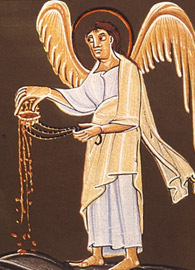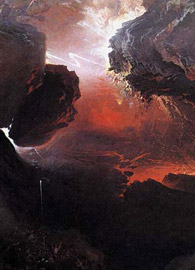Revelation Week 6
The Seventh Seal: A Trumpet Fanfare to the Victory of God (Revelation 8:2–11:19)
By Rob Wall
Seattle Pacific University Paul T. Walls Professor of Scripture and Wesleyan Studies
Read this week’s Scripture: Revelation 8:2–11:19
22:31
Podcast read by Carla M. Wall

 Enlarge
Enlarge
We bought our first home in Texas, where we first noticed blackened lawns. The practice of burning Bermuda grass in the spring is still carried on by those who notice that lush lawns result in the summer. The fire destroys, but only then to renew. Keep this image of blackened lawns in mind while studying this section of Revelation.
Purifying Judgment Makes Way for Renewal
The exalted Lamb has now broken all seven seals that had strapped the scroll shut, and it now lies fully open in the hand of another of heaven’s “powerful angel[s]” (Revelation 10:1–2). With heaven’s publication of its contents God’s comprehensive plan to restore creation is now in effect (see 5:1). The dramatic silence prepares heaven for worship (8:1). John observes another seven angels and then another still, acolytes of the heavenly temple (see 11:19) who assist God in receiving “the prayers of all the saints” (8:3–4; cf. 6:9).
God’s response to these prayers prompts an abrupt change in venue of John’s revelation from heaven to earth. The earlier destructive winds that traveled with the four horsemen who destroyed a quarter of earth (6:8) are now replaced by fire from the temple’s altar, thrown down to earth (8:5) to burn a third of what remains (8:6–12). We sense the petitions of the saints have requested God’s judgment of a creation no longer fit for life as the Creator intended it (see 4:11). In this sense the altar’s fire symbolizes God’s purifying judgment, which John envisions over the next four chapters. It is the cleansing of a broken earth, inaugurated on the cross, that readies the earth for renewal.
The images of a cosmic storm that begin (8:5) and conclude (11:19) this section of Revelation recall the theophany on Mount Sinai when God makes a house call on Israel (cf. Exodus 19:17–18; 20:18). Then too God’s appearance to address God’s people is sounded by trumpet fanfare (cf. Exodus 19:19; 20:18; Hebrews 12:18–19) and comes with expectation that only a purified people could meet with God. Even creation, which still awaits its restoration (cf. Romans 8:18–25), must prepare itself for the apocalypse of God’s salvation (cf. 1 Thessalonians 4:16–17)! The paschal Lamb’s slaughter has already begun a forgiven people’s preparations for God’s final house call [Author’s Note 1], when the heavenly Jerusalem comes to earth and the victory of God now realized in heaven will also be realized on earth.
Four Trumpets of Devastating Purification
Much like the first four seal judgments, which introduce the four horsemen who ride the earth carrying weapons of mass destruction (see Revelation 6:1–8), the first four trumpet fanfares also announce a quartet of visions. But instead of sounding from the four corners of earth (cf. 7:1–2), this trumpet quartet envisions the arrival of God’s purifying fire among the four elements of the natural world (rather than among its creaturely inhabitants as before when the seals were broken): earth, sea, water, and heavens. While the repetition of “a third” (rather than one quarter as before) suggests an intensification of God’s anger at what God observes on earth, its focus is still not all of creation —a global devastation but not a total destruction of the created order (8:7–12). On the cross, God’s “no” to evil intends to leave room for the “yes” of repentance and restoration. God leaves the choice to us (but see the heartbreaking 9:20–21!).
Drawing repeatedly from the Exodus story, and perhaps the most important Old Testament typology of God’s salvation in the New Testament, the initial quartet of judgments allude to the plagues used by the Creator to liberate Israel from Egyptian bondage and to reassert lordship over the land (cf. Revelation 8:7 and Exodus 9:13–35; Revelation 8:12 and Exodus 10:21–23). There too, as here, God receives petitions for help from the people (Exodus 2:23). But the Exodus story explains that God’s liberating response is an act of faithfulness to promises made to Sarah and Abraham (Exodus 2:24). Here too God’s fiery response in judgment is an act of God’s faithfulness in putting creation to rights, which travels at “the terrible speed of mercy,” as Flannery O’Connor calls it. [Author’s Note 2] It is the Creator’s judgment of the chaos sin has caused in the natural order; hence, creatures are used as cleansing agents — stars and sun, hail and fire to wreak God’s havoc on a world gone to hell. But the way of salvation is such that going to hell is sometimes the route to heaven: purifying creation prepares for God’s new creation, which John will envision (as we will!) toward the end of Revelation.

 Enlarge
Enlarge
Of course, nature supplies humanity with the sources of life, and so we may imagine that the initial trumpet quartet sounds a human calamity. Indeed, the creation narrative suggests that the creatures of day three, when God created earth, and day six, when God created humans, are inextricably linked in the biblical narrative. Hence, it seems logical that the vulture (probably not an “eagle”) alerts the prophet that he is about to witness “horror, horror” — two expansive visions of destruction visited on those people “who live on earth” (Revelation 8:13). Even though a third trumpet fanfare will announce a seventh act in this drama of divine judgment (see 11:15–18), it consists of lyrics that a chorus sings to commemorate the results of the Creator’s awful victory but does not further describe creation’s devastation.
Two Horrors Unleashed on an Idolatrous World
The first horror introduced by the fifth trumpet fanfare (9:1–12) alerts John to a falling star (probably another angel) who unlocks a bottomless and subterranean “abyss” (9:1; cf. 1 Enoch 18:12–16; 21:7–10; 108:3–6), which in Revelation is a dwelling place for evil beings (cf. Revelation 11:7; 17:8; 20:1–3). A swarm of awful insects is released through the abyss’s smokestack, led by king Abaddon, “The Destroyer” (cf. Exodus 12:23); they are hybrid models that combine the scales and wings of locusts for protection and speed (Revelation 9:7–11; cf. Joel 2:1–11) with the powerful sting of the scorpion to inflict Job-like suffering on people for a period of five months (9:5, 10).
Again, this siege of profound agony is nasty but temporary: divine judgment is a means to a redemptive end, not the end itself. For this reason unrepentant people will want to die but cannot (9:6); there is a price to pay for sin. On the other hand, pain doesn’t come to those with “the seal of God [tattooed] on their foreheads” (9:4) because their sins already have been cleansed in the Lamb’s redeeming blood (see 7:3–8, 14). Gospel, folks!
The second horror of plagues is sounded by the trumpet blast of the sixth angel (9:13–19). The reference to “the gold altar” (9:13) reminds readers of the heavenly origins of these horrors, which envision God’s purifying judgment in response to the prayers of all the saints (8:3–5). The newest band of angels is released from the Euphrates where God’s enemies are encamped (Isaiah 7:20; 8:7; Jeremiah 46:10) for a predetermined mission of mischief (Revelation 9:15). They lead a demonic cavalry that targets the destruction of a third of those unfortunate unbelievers who remain (9:18).
This vision of creation’s devastation is admittedly over-the-top — a Hollywood-esque apocalypse! But John’s witness communicates an important theological truth about God’s way of salvation: humanity’s daily experience of a world plagued by evil should bring repentance and a turning to the loving, peace-making ways of God. But there’s another haunting truth written into the heartbreaking snapshot John takes of unrepentance that concludes this vision of evil’s reign of terror (9:21): people continue to worship idols that can’t see or hear or walk (9:20).
John surely recognizes that there was precious little idol-free space for the Roman Christians who first heard Revelation read aloud. Their activities of daily life required decisions in business and social life that implicated them deeply in local traditions of idol worship. Our world is not the Roman world of Revelation; however, the similarities are many. Our reading of Revelation is shaped by a world of social media and personal technologies that preoccupy us and integrate us into an idolatrous culture of self-absorption. The Old Testament prophets speak of idolatry as a failure of attentiveness — the inability or unwillingness to focus our attention and desire upon God in the face of myriad distractions. In the face of evil, people refuse to choose God because their minds are absorbed elsewhere, and the Christian life is a calling that demands our undivided attention. Perhaps God’s scroll, now opened by the Lamb, holds the prospect of a different result for unrepentant humanity. To this prospect John now turns.
John Commissioned by the Seventh Angel
The appearance of “another powerful angel” (10:1; cf. 5:2) in John’s vision of the seven seals signals a moment of special importance. The prophet seems to know this by his elaborate description of the angel’s appearance, which is like none other in Revelation: its task is to hand-deliver God’s scroll (5:1), which the Lamb received and has now fully opened, to John to write down as promised in Revelation’s opening verse (see 1:1; cf. 1:19; 22:16). This angel holds open the scroll (10:2). [Author’s Note 3] Its description (10:1) discloses its heavenly provenance, including the rainbow that encircles God’s throne (4:3), the sun that illumines the face of the risen Son (1:16), and the thunderous voice that calls us to attention (4:5). This mighty angel is engaged in God’s work: to transmit the metanarrative of the apocalypse of God’s salvation, which God had first given Jesus, to John in order to prepare the saints for what is soon to take place on earth (1:1, 3).
Revelation doesn’t tell us why the prophet is instructed not to add his exposition to the scroll, but based upon the angel’s thunderous audition, two suggestions are possible. What is written on God’s scroll is a complete revelation; nothing more should be added to or subtracted from it (cf. 22:18–19). More likely, it responds to John’s discouraging report that if God’s over-the-top judgment of evil doesn’t produce the hoped for repentance (see 9:20–21), then why add more misery to creation’s already miserable condition? In either case the Lamb has now opened the scroll on the cross and in the empty tomb. The glad tiding of God’s salvation has now been published and has begun to have its redemptive result. The angel announces to John, “The time is up,” (10:6); let’s get this show on the road so the Creator’s purposes are accomplished according to the promises God made to Israel’s prophets (10:7). [Author’s Note 4]
Following the example of Ezekiel, who was also given a scroll filled with writing on both sides (Ezekiel 2:9–10) and instructed to eat it (Ezekiel 3:1), John is fed the scroll and, as before in Ezekiel’s case, it is “sweet as honey” to the taste but upsets his stomach when digested (Revelation 10:10). John’s act cues the commissioning of Ezekiel who was also exiled and called to go to an unrepentant people, first with a warning of death (Ezekiel 3:20) but also with a promise of life for those who repent (Ezekiel 3:21). John’s new commission to “prophesy again” (Revelation 10:11) to the churches is read afresh by Ezekiel’s story: the heralding of God’s salvation, which has already arrived on earth because of Jesus, includes a warning of death for those who do not repent (cf. 9:20–21) but a promise of life for those who do.
The Gentiles Versus the Two Witnesses
Ignore the division of chapters to connect 10:11 without pause with what follows: the gospel that John proclaims (10:11) is based upon the measurements he takes of “God’s temple” (11:1), which is opened “in heaven” and contains “the chest containing [God’s] covenant” (see 11:19). To measure the temple and count the worshipers found there is to confirm that it is there — and in particular the chest that contains the promise of God’s new covenant is there along with the altar on which the sacrifice of the paschal Lamb has already secured this promise. John takes the measure of what is now proclaimed in the nations as gospel!
God further instructs the prophet not to take the measure of the courtyard “outside the temple,” which is the reserve of those unrepentant Gentiles [Author’s Note 5] who “will trample the holy city [i.e., the Church] underfoot for forty-two months” (11:2). [Author’s Note 6] The instruction not to measure the courtyard confirms that the promises of God will not be fulfilled among those who do not believe (= “Gentiles”) because their minds and hearts remain unchanged (see 9:20–21).
The same time period of the mischief afflicted by “the Gentiles” upon God’s people restricts in days (= 1260) the rival ministry given to “two witnesses” (11:3–13). [Author’s Note 7] The “two witnesses” are given what only God can dispense: the power to prophesy “before the Lord of the earth” (11:4) and by the “breath of life from God” (11:11) [Author’s Note 8] in praise of “the God of heaven” (11:13).
Why “two” witnesses? Because two witnesses are necessary for making God’s case (see Deuteronomy 19:15). Who are they? If the rival “Gentiles” are nonbelievers whose mission to destroy God’s people takes place over three and half months in Revelation’s apocalyptic time zone, then the “two witnesses” must represent believers over this same span of time. Yes, forgiveness and the realization of the promise of a new covenant are the effects of the Lamb’s sacrifice. But the effect of proclaiming these glad tidings is the costly conflict over Jesus that this provokes from the church’s beginning (read Acts!). The misery God describes to John in 11:5–13 is the result of this confrontation between God’s people (= two witnesses) and those who refuse to repent and who remain opposed to God’s gospel (= Gentiles; cf. 9:20–21).
Even more startling is that those who gloat over the bodies of martyred saints (11:7–8) and refuse them burial rights (a horrendous offense in the Jewish culture) are numbered from “the peoples, tribes, languages, and nations” (11:9–10), the very ones for whom Christ died (cf. 5:9–10) and to whom God’s mission is now directed (10:11). I contend that this snapshot of the civil war between God’s people and God’s enemies, and the fearful images of suffering it contains, occupies the centerpiece of Revelation’s pastoral message: the church bears witness to God’s victory in Christ by participating in his suffering, sometimes even in his death, until his return to realize on earth what is already so in heaven. Indeed, the “hour” of destruction that brings this second horror to an end (11:13–14) gives “glory to the God of heaven” as victor.
The final trumpet fanfare does not announce a “third horror” (11:14), which is “coming soon” (and described in 12:1–19:10), but rather the decisiveness and finality of God’s victory over “the Gentiles” (11:2; so 11:13): “the kingdom of the world has become the kingdom of our Lord and his Christ […] forever and always” (11:15). The lyrics of the triumphant chorus are sung by heaven’s vocal assembly (11:15–18) in worshipful praise of the Lord God Almighty whose rule over creation has been enforced by judgment (11:16–18). The judgment is just, since the punishment of the Gentiles matches their crime (11:18): those who have destroyed the earth are themselves destroyed.
Although this is a heavenly scene, what is announced in heaven will assuredly happen on earth; but we must await the end of Revelation to find out how God finally destroys the destroyers as the purifying act of the Creator who is utterly faithful to creation and to the promise of restoring it anew. This story of God’s purifying earth of its destroyers is the “third horror” (11:14) plotted by the next several chapters.
For this moment, however, the vision of the seals — a vision about the present results of Jesus’ past work on the cross — happily concludes in heaven rather than on earth: John sees the temple’s open door, and through it he catches a glimpse of the hope chest — the “ark of [the] covenant” (11:19) — that contains elements of God’s promise of an enduring covenant with God’s people that nothing, “not death or life, not angels or rulers, not present or future things” (Romans 8:38) can or will threaten.
Questions for Further Reflection
- It seems that the Christian witness most noticed by the world today rather systematically takes the form of cynical, judgmental ranting against liberals. Since God is doing rather dramatic judging in Revelation, the two Christian witnesses are left to testify to forgiveness and to God’s covenant promises. Judging is not their task at all. Where and how can Christians begin today to witness to the Good News without a focus on judging? What does a new template for witnessing look like?
- God “wants all people to be saved and to come to a knowledge of the truth”(1 Timothy 2:4). How can you argue the truth of this passage amidst all the horrors of Revelation?
- How can the American Church particularly prepare our children to be sharers in Christ’s suffering when all around they are being conditioned to value the power of celebrity?
<<Previous Lectio Back to Revelation Next Lectio>>

This work is licensed under a Creative Commons License.




